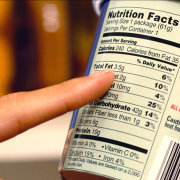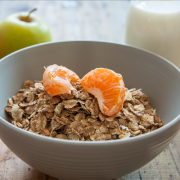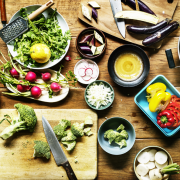The human gut is one of the most dynamic yet undervalued organs in the human body. Interestingly, changes in our diet, especially dietary fibre, is one of the big influencers of a healthy gut to support the complex ecosystem that plays such a vital role to our health.
A Focus on Fibre
It’s well-known that our guts need fibres to keep it healthy. Fibre is found in plant-based foods such as fruit, vegetables, legumes, and wholegrains, and is the part of the plant that cannot be broken down by the gut. Our gut needs different types of fibres to keep it healthy, each of which have different jobs in the gut. Soluble fibre acts like a mop and helps absorb fluid in the gut, forming a soft, gelish mush that helps the stool to easily pass through the gut. It is found in oats, oat bran, oranges, bananas, apples, carrots, berries, and legumes like lentils, beans and chickpeas. The other type of fibre is insoluble fibre. Insoluble fibre acts like a broom, roughly sweeping through the length of the gut to remove waste. Found naturally in wholegrains like oats, corn, high fibre bread, bran and brown rice, as well as in nuts, seeds, and the skin of fresh produce, insoluble fibre does not dissolve in water.
How Much Fibre Do I Need?
Many South Africans fall short of their recommended fibre intake each day. It is recommended that women consume at least 25g of fibre per day and men at least 38g of fibre. A 2015 review that surveyed the diets of South African adults showed that fibre intake in women and men could be as low at 16g and 18g, respectively.
What is Fibre Impotent in the Diet?
Fibre does far more than manage constipation and keep us regular. It is not widely appreciated but the gut is home to 60% of our immunity, highlighting the link between fibre., and healthy gut and a strong immune system. Fibre may play a role in preventing colon cancer. Cholesterol-lowering benefits are seen when soluble fibre dissolves, binding cholesterol that is then removed by the gut. Foods rich in fibre tend to be low in energy too, assisting with weight loss. Furthermore, fibre-rich foods are naturally nutrient-rich (like wholegrains, fruit and vegetables), boosting our nutrient intake for an overall healthier diet.
Evidence shows that very low carb diets are also too low in fibre. Diets low in fibre tend to be naturally higher in meat and fat which can cause enzymes in the colon to breakdown cancer-causing carcinogens. For this reason, the South African food-based dietary guidelines recommend that we eat at least five portions (400g) of a variety of fruit and vegetables each day to help meet our fibre needs, along with other fibre-rich foods.
The Role of Fibre in the Gut
The bacteria in the gut help digest food, regulate our immune system, protect against the harmful bacteria that cause disease, and even produce some vitamins. The gut is home to 40 trillion microorganisms which shows the huge responsibility that fibre (along with the collection of gut microbes, called gut microbiota) plays in optimal health and wellbeing. Fibre helps create a good environment for the growth of the gut microbiota, the friendly bacteria that make a home in our gut. The gut microbiota can be bacteria (e.g. lactobacilli or bifidobacteria) or yeast (e.g. Saccharomyces boulardii) and are found naturally in fermented foods like yoghurt, maas (amasia), kefir and sauerkraut, or can be taken as a supplement. When eaten, the gut microbiota pass through the gut and multiply to live along the length of the gut. Fibre acts as a source of food for these healthy bacteria to grow and thrive, feeding the good gut bacteria. Foods such as bananas, onions, garlic, oats, and barley in particular are good prebiotics.
Finding Fibre on Food Labels
Reading food labels is a great tool to help improve your nutrient and fibre intake. According to guidelines, nutrition claims on food labels in South Africa state that for a product to be considered high in fibre it needs to contain more than 6g of fibre per 100g. To be labelled as a source of fibre, the product needs to contain at least 3g of fibre per 100g.
Fibre clearly plays a key role in optimizing the health of the complex gut ecosystem. It is important to note that a diet rich in fibre from fruit and vegetables would naturally be rich in nutrients such as vitamins, minerals, antioxidants and phytonutrients, so it’s a win-win situation to choose high fibre, nutrient-rich foods as part of your daily diet.
- FitChef meals that are a source of fibre include Red Kidney Bean Goulash with Pumpkin & Spinach, Lentil Tomato Breedie with Sweet Potato Mash & Green Beans, Lentil Bobotie with Carrot & Peas, Grandma's Vegetable Curry with Brown Basmati Rice with Chutney, Grandma's Mince Curry with Brown Basmati Rice with Chutney, and Farmstyle Beef Bobotie with Carrots & Peas.
- Start your day on a fibre high with FitChef’s breakfasts like Luxury Rolled Oats with Cranberries, Cashew, & Apple Cinnamon and Toasted Wheat Flakes.
- Refined starches are a no-go at FitChef and we use only high fibre wholegrains like brown rice, wholewheat pasta, quinoa, oats, and bran. FitChed meals such as Spanish Chicken and Quinoa, Mediterranean Chicken with Roasted Vegetables & Brown Basmati Rice, Whole Wheat Penne Bolognese and Chicken Hotpot with Quinoa and Mixed Vegetables contain wholegrains.
- The FitChef vegetarian meals use super high fibre legumes like beans, chickpeas and lentils.
- FitChef smoothies are fibre-filled as we blend all edible parts of the fruit and veg, like the skins, pips and seeds. The whole, fresh fruit is diced, chopped and blended with other natural ingredients to ensure our smoothies retain as much nutrition and fibre as possible- a double win for gut health.
- Improve the quality of your food.
- Reduce or stop eating refined carbohydrates.
- Reduce or stop eating added sugars.
- Reduce or stop eating junk food.
- Eat a lot more vegetables, especially your greens.
- Manage your portion size.
- You can’t out-train a bad diet (i.e. exercise won’t make you thin).
References
- Bradbury KE, Appleby PN, and Key TJ. Fruit, vegetable, and fibre intake in relation to cancer risk: findings from the European Prospective Investigation into Cancer and Nutrition (EPIC). American Journal of Clinical Nutrition. 2014;100(suppl):394S–8S.
- Eswaran S, Muir J, Chey WD. Fibre and Functional Gastrointestinal Disorders. American Journal of Gastroenterology. 2013; 108:718–27.
- Government Gazette. R429 Foodstuffs, Cosmetics and Disinfectants Act, 1972 (Act 54 Of 1972). Regulations Relating to the Labelling and Advertising of Foodstuffs. Department of Health, 2014.
- Mayer EA, Tillisch K, Gupta A. Gut/brain axis and the microbiota. Journal of Clinical Investigation. 2015;125(3):926–38.
- Mchiza ZJ et al. A Review of Dietary Surveys in the Adult South African Population from 2000 to 2015. Nutrients. 2015;7:8227-50.
- Mugdil D, Barak S. Composition, properties and health benefits of indigestible carbohydrate polymers as dietary fibre- a review. International Journal of Biological Macromolecules. 2013; 61: 1-6.
- Naude CE. Food-Based Dietary Guidelines for South Africa: The "Eat plenty of vegetables and fruit every day". South African Journal of Clinical Nutrition. 2013;26(3)(Supplement):S46-S56.
- Sender R, Fuchs S, Milo R. Revised Estimates for the Number of Human and Bacteria Cells in the Body. PLoS Biol. 2016;14(8).

 No added or artificial sugars
No added or artificial sugars The cleanest ingredient labels
The cleanest ingredient labels






